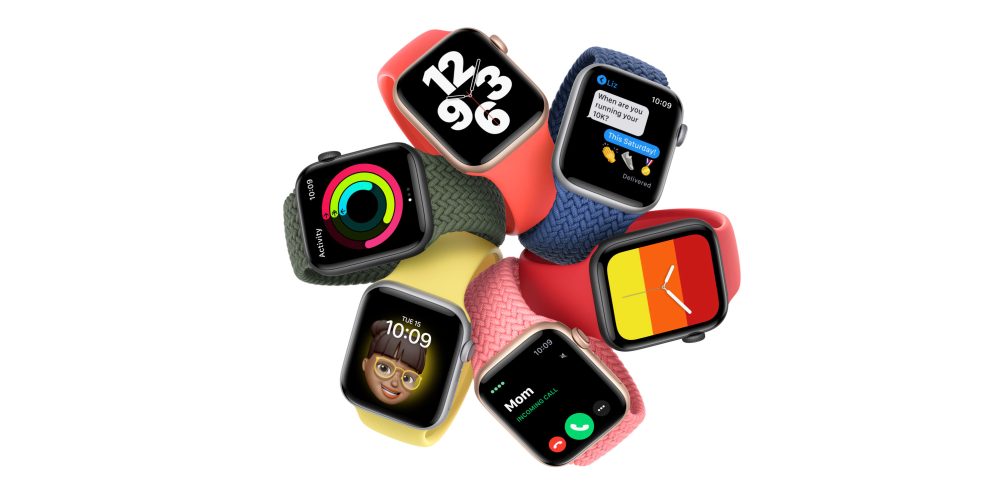
The first reviews of the Apple Watch Series 8 and second-generation Apple Watch SE are out. Ahead of pre-orders arriving to buyers on Friday, these early reviews provide our first in-depth look at the modest Apple Watch Series 8 upgrades and the new generation of the entry Apple Watch models with SE 2.
To The Verge, most Apple Watch Series 8 upgrades are invisible to the naked eye, as it has exactly the same design with slightly different colors. The review notes how the body temperature sensor works, as Apple didn’t provide much information about it:
The watch’s temperature sensing is mostly passive. Unlike the existing EKG, heart rate, and blood oxygen sensors, you can’t take on-demand readings. You can only get wrist temperature readings when you have the Sleep Focus turned on and sleep tracking enabled. Plus, you need to sleep with the Apple Watch for five nights to establish a baseline. Once that’s completed, you’re only going to see deviations from that baseline. You’re never really going to look at your wrist and go, “Oh, I have a fever because my temperature is 100 degrees Fahrenheit.”
(…) If you happen to track your cycles in the Health app, enabling wrist temperature readings means you can get retrospective ovulation estimates after about two cycles.
Tom’s Guides talks about the new Car Crash Detection feature, highlighting two improved sensors of the Apple Watch Series 8:
The Apple Watch Series 8 features two new motion sensors inside, plus an improved gyroscope and accelerometer. These together can sample motion 4x faster than before, so the watch will be able to detect a crash precisely as it happens. And, in the unfortunate case of a crash, the Apple Watch will automatically call emergency services and notify your emergency contacts. Though it’s a somber thought, quicker help could be a matter of life or death.
Engadget notes that the new S8 chip isn’t faster but could improve battery in general:
Though the Series 8 uses a newer S8 system-in-package processor, it didn’t feel dramatically faster than its predecessor. It did last a little longer in general, though I need more time testing to know for sure. I also suspect that the larger size might have something to do with this. I used the new low power mode in watchOS 9 one morning when the Series 8 was down to 20 percent battery and I still had to run to the gym for an 8am workout. It managed to last another two hours at least while also being able to track my performance during the HIIT class. I was impressed by how little it felt like I had to sacrifice in exchange for the extra juice.
The Wall Street Journal praises the new Low Power mode:
[Low Power mode] cuts the always-on display and background heart-rate measurements while keeping activity tracking and fall detection—ideal for long flights or a weekend away without a charger (…) In my tests, low power mode extended the battery life of the Series 8—as well as my older Series 7 watch. The watches even had some battery left after 36 hours, but needed to be topped up to 30% for a second night of sleep tracking. (Apple’s 36-hour estimate is based on testing that doesn’t include sleep tracking, though sleep tracking still works when the feature is enabled.)
TechCrunch, for example, highlights the importance of emergency features, especially for older users. One of the new features is International Emergency Calling:
International Emergency Calling expands the feature for people traveling abroad, covering some 120 countries/regions across the world. The system can also be triggered if the watch detects a fall. These aren’t “sexy” features, by any measure — and that likely contributed to the somewhat muted response around the product’s launch. I’d hazard to guess that these kinds of additions aren’t exactly the kind of features that move the needle for too many users, but Apple is building up a strong case as a device for older users and those with known health issues.
Apple Watch SE (2022) reviews

The Streets sums what’s like to choose the new Apple Watch SE in 2022:
The Apple Watch SE is best for if you’re new to Apple Watch, don’t need all the health features of a display that is always-on, or if you have an older model like a Series 1, 2, or 3.
Engadget doubles down on The Streets review by highlighting what you lose when choosing the Apple Watch:
The main features you’ll miss if you opt for an SE instead of a Series 8 is the Always On Display (AOD), ECG reader, blood oxygen app and the new skin temperature sensor. Like the older SE, this year’s model also charges at a slower rate than the Series 7 and 8, and doesn’t have a U1 chip for ultra wideband. It also lacks the IP6X dust resistance rating of its more premium counterparts, so if you’re likely to take this Tough Mudding or to the beach, it might be worth considering a more expensive model. Those who hate chunky bezels will also find the SE’s thicker borders off-putting, but without a side-by-side comparison I didn’t notice a big difference.
The Wall Street Journal talks about little differences between Apple Watch SE 2 predecessor and for who this smartwatch could be worth it:
SE ($249 and up): If you want the basic activity tracking and safety features, get the SE. There’s no always-on display, temperature sensor, blood-oxygen sensor or ECG app. Like the Series 8, it’s water-resistant down to 50 meters.
Apple Watch Series 8 and Apple Watch SE 2 video reviews
FTC: We use income earning auto affiliate links. More.



Comments